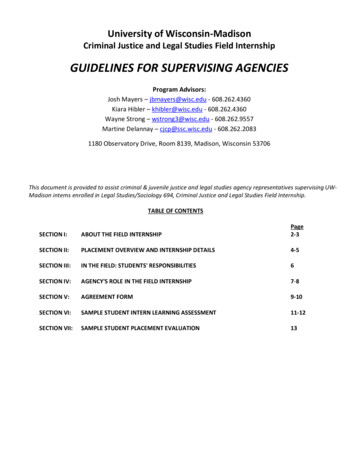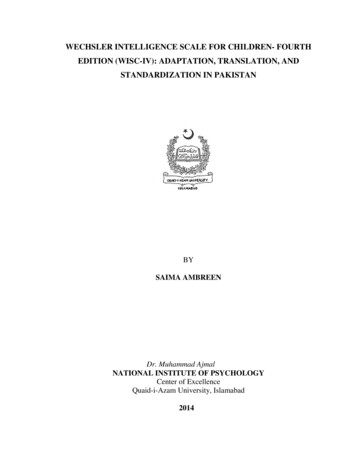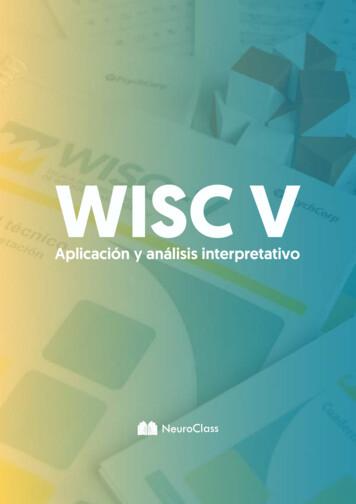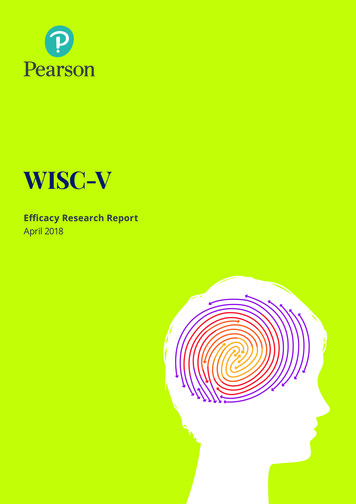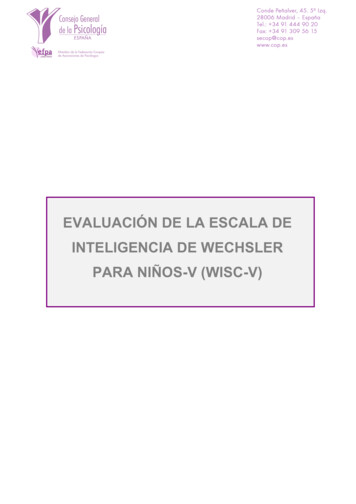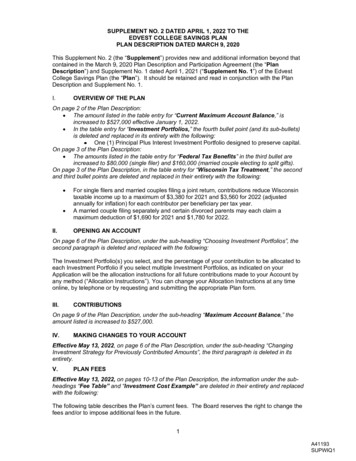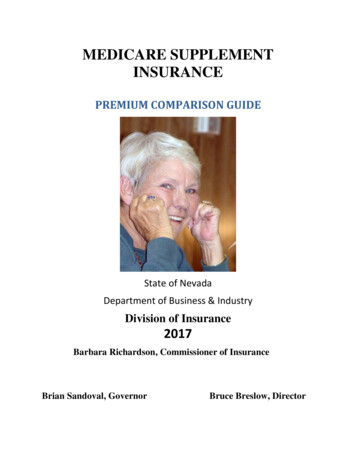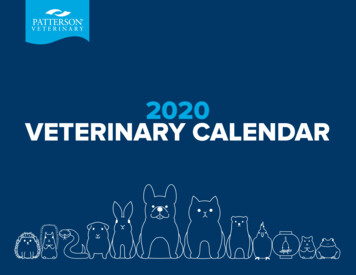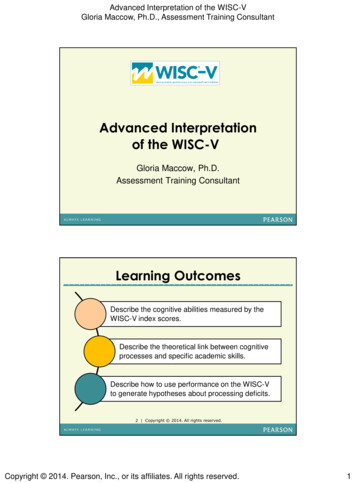
Transcription
Technical and InterpretiveManual Supplement:Special Group Validity StudiesWith Other Measures andAdditional Tables
PsychCorp is an imprint of Pearson Clinical Assessment.Pearson Executive Office 5601 Green Valley Drive Bloomington, MN 55437800.627.7271www.PearsonClinical.comCopyright 2014 NCS Pearson, Inc. All rights reserved. Portions of this work were previously published.Warning: No part of this publication may be reproduced or transmitted in any form or by any means,electronic or mechanical, including photocopy, recording, or any information storage and retrieval system,without permission in writing from the copyright owner.Pearson, the PSI logo, PsychCorp, the Wechsler Intelligence Scale for Children, and WISC aretrademarks, in the U.S. and/or other countries, of Pearson Education, Inc. or its affiliate(s).Printed in the United States of America.Product Number: 0150015089
Technical andInterpretive ManualSupplement:Special Group ValidityStudies With Other Measuresand Additional TablesDavid WechslerWISC–V Research DirectorsSusan Engi Raiford, PhDJames A. Holdnack, PhD
ContentsIntroduction . . . . . . . . . . . . . . . . . . . . . . . . . . . . . . . . . . . . . . . . . . . . . . . . . . . . . . . . . . . . . . . . . . . 1Brief Descriptions of Other Measures . . . . . . . . . . . . . . . . . . . . . . . . . . . . . . . . . . . . . . . . . . . 3Vineland–II . . . . . . . . . . . . . . . . . . . . . . . . . . . . . . . . . . . . . . . . . . . . . . . . . . . . . . . . . . . . . . . . . . . 3WIAT–III . . . . . . . . . . . . . . . . . . . . . . . . . . . . . . . . . . . . . . . . . . . . . . . . . . . . . . . . . . . . . . . . . . . . . 3BASC–2 PRS . . . . . . . . . . . . . . . . . . . . . . . . . . . . . . . . . . . . . . . . . . . . . . . . . . . . . . . . . . . . . . . . . . 3Brown ADD . . . . . . . . . . . . . . . . . . . . . . . . . . . . . . . . . . . . . . . . . . . . . . . . . . . . . . . . . . . . . . . . . . . 4Results of Special Group Validity Studies With Other Measures . . . . . . . . . . . . . . . . 4Intellectual Disability . . . . . . . . . . . . . . . . . . . . . . . . . . . . . . . . . . . . . . . . . . . . . . . . . . . . . . . . . . 4Correlations With the Vineland–II . . . . . . . . . . . . . . . . . . . . . . . . . . . . . . . . . . . . . . . . . . . . . . 4Specific Learning Disorder-Reading and Specific LearningDisorder-Reading and Written Expression . . . . . . . . . . . . . . . . . . . . . . . . . . . . . . . . . . . . . . . . 8Correlations With the WIAT–III . . . . . . . . . . . . . . . . . . . . . . . . . . . . . . . . . . . . . . . . . . . . . . . 8Specific Learning Disorder-Mathematics . . . . . . . . . . . . . . . . . . . . . . . . . . . . . . . . . . . . . . . . 13Correlations With the WIAT–III . . . . . . . . . . . . . . . . . . . . . . . . . . . . . . . . . . . . . . . . . . . . . . 13Attention-Deficit/Hyperactivity Disorder . . . . . . . . . . . . . . . . . . . . . . . . . . . . . . . . . . . . . . . 17Correlations With the BASC–2 PRS . . . . . . . . . . . . . . . . . . . . . . . . . . . . . . . . . . . . . . . . . . . . 17Correlations With the Brown ADD . . . . . . . . . . . . . . . . . . . . . . . . . . . . . . . . . . . . . . . . . . . . 19Disruptive Behavior . . . . . . . . . . . . . . . . . . . . . . . . . . . . . . . . . . . . . . . . . . . . . . . . . . . . . . . . . . . 22Correlations With the BASC–2 PRS . . . . . . . . . . . . . . . . . . . . . . . . . . . . . . . . . . . . . . . . . . . . 22Traumatic Brain Injury . . . . . . . . . . . . . . . . . . . . . . . . . . . . . . . . . . . . . . . . . . . . . . . . . . . . . . . . 24Correlations With the BASC–2 PRS . . . . . . . . . . . . . . . . . . . . . . . . . . . . . . . . . . . . . . . . . . . . 24Autism Spectrum Disorder With Accompanying Language Impairment . . . . . . . . . . . . 26Correlations With the BASC–2 PRS . . . . . . . . . . . . . . . . . . . . . . . . . . . . . . . . . . . . . . . . . . . . 26Autism Spectrum Disorder Without Accompanying Language Impairment . . . . . . . . . 33Correlations With the BASC–2 PRS . . . . . . . . . . . . . . . . . . . . . . . . . . . . . . . . . . . . . . . . . . . . 33Summary . . . . . . . . . . . . . . . . . . . . . . . . . . . . . . . . . . . . . . . . . . . . . . . . . . . . . . . . . . . . . . . 39Appendix F. WISC–V Stability Coefficients, by Age Group . . . . . . . . . . . . . . . . . . . . 40Appendix G. Intercorrelations of WISC–V Scores, by Age Group . . . . . . . . . . . . . . . 48Appendix H. Correlations Between the WISC–Vand the KTEA–3 and WIAT–III, by Age Group . . . . . . . . . . . . . . . . . . . . . . . . . . . . . . . . 71References . . . . . . . . . . . . . . . . . . . . . . . . . . . . . . . . . . . . . . . . . . . . . . . . . . . . . . . . . . . . . . . . . . . . 84iiiWISC–5 Technical and Interpretive Manual Supplement Copyright 2014 NCS Pearson, Inc. All rights reserved.
List of TablesTable 1Demographic Data for the Validity StudiesWith Other Measures in Special Groups . . . . . . . . . . . . . . . . . . . . . . . . . . . . . . . 2Table 2Correlations Between the WISC–V and theVineland–II for the Intellectual Disability Group . . . . . . . . . . . . . . . . . . . . . . . . . 5Table 3Correlations Between WISC–V ComplementaryScores and the Vineland–II for the Intellectual Disability Group . . . . . . . . . . . . . 7Table 4Correlations Between the WISC–V and theWIAT–III for the Specific Learning Disorder-Readingand Reading and Written Expression Groups . . . . . . . . . . . . . . . . . . . . . . . . . . . 9Table 5Correlations Between WISC–V Complementary Scoresand the WIAT–III for the Specific Learning Disorder-Readingand Reading and Written Expression Groups . . . . . . . . . . . . . . . . . . . . . . . . . . . 11Table 6Correlations Between the WISC–V and the WIAT–IIIfor the Specific Learning Disorder-Mathematics Group . . . . . . . . . . . . . . . . . . . 14Table 7Correlations Between WISC–V Complementary Scores and theWIAT–III for the Specific Learning Disorder-Mathematics Group . . . . . . . . . . 16Table 8Correlations Between the WISC–V and the BASC–2 PRSfor the Attention-Deficit/Hyperactivity Disorder Group . . . . . . . . . . . . . . . . . . 18Table 9Correlations Between WISC–V Complementary Scores and theBASC–2 PRS for the Attention-Deficit/Hyperactivity Disorder Group . . . . . . . 18Table 10Correlations Between the WISC–V and the Brown ADDfor the Attention-Deficit/Hyperactivity Disorder Group . . . . . . . . . . . . . . . . . . 20Table 11Correlations Between WISC–V Complementary Scores and theBrown ADD for the Attention-Deficit/Hyperactivity Disorder Group . . . . . . . . 21Table 12Correlations Between the WISC–V and the BASC–2 PRSfor the Disruptive Behavior Group . . . . . . . . . . . . . . . . . . . . . . . . . . . . . . . . . . . 23Table 13Correlations Between WISC–V Complementary Scores and theBASC–2 PRS for the Disruptive Behavior Group . . . . . . . . . . . . . . . . . . . . . . . . 23Table 14Correlations Between the WISC–V and the BASC–2 PRSfor the Traumatic Brain Injury Group . . . . . . . . . . . . . . . . . . . . . . . . . . . . . . . . 25Table 15Correlations Between WISC–V Complementary Scores and theBASC–2 PRS for the Traumatic Brain Injury Group . . . . . . . . . . . . . . . . . . . . . 25Table 16Correlations Between the WISC–V and the BASC–2 PRSfor the Autism Spectrum Disorder With Language Impairment Group . . . . . . . 27Table 17Correlations Between WISC–V Complementary Scores and the BASC–2 PRSfor the Autism Spectrum Disorder With Language Impairment Group . . . . . . . 30Table 18Correlations Between the WISC–V and the BASC–2 PRS for theAutism Spectrum Disorder Without Language Impairment Group . . . . . . . . . . 34Table 19Correlations Between WISC–V Complementary Scores and the BASC–2 PRSfor the Autism Spectrum Disorder Without Language Impairment Group . . . . . 37Table F.1Stability Coefficients of Subtest, Process,and Composite Scores, by Age Group . . . . . . . . . . . . . . . . . . . . . . . . . . . . . . . . . 41Table F.2Stability Coefficients of Complementary Subtestand Composite Scores, by Age Group . . . . . . . . . . . . . . . . . . . . . . . . . . . . . . . . . 46ivWISC–V Technical and Interpretive Manual Supplement Copyright 2014 NCS Pearson, Inc. All rights reserved.
Table G.1Intercorrelations of Subtest, Process, and Composite Scores for Age 6 . . . . . . . . 49Table G.2Correlations of Complementary Scores WithAll Subtest, Process, and Composite Scores for Age 6 . . . . . . . . . . . . . . . . . . . . . 50Table G.3Intercorrelations of Subtest, Process, and Composite Scores for Age 7 . . . . . . . . 51Table G.4Correlations of Complementary Scores WithAll Subtest, Process, and Composite Scores for Age 7 . . . . . . . . . . . . . . . . . . . . . 52Table G.5Intercorrelations of Subtest, Process, and Composite Scores for Age 8 . . . . . . . . 53Table G.6Correlations of Complementary Scores WithAll Subtest, Process, and Composite Scores for Age 8 . . . . . . . . . . . . . . . . . . . . . 54Table G.7Intercorrelations of Subtest, Process, and Composite Scores for Age 9 . . . . . . . . 55Table G.8Correlations of Complementary Scores WithAll Subtest, Process, and Composite Scores for Age 9 . . . . . . . . . . . . . . . . . . . . . 56Table G.9Intercorrelations of Subtest, Process, and Composite Scores for Age 10 . . . . . . . 57Table G.10 Correlations of Complementary Scores WithAll Subtest, Process, and Composite Scores for Age 10 . . . . . . . . . . . . . . . . . . . . 58Table G.11 Intercorrelations of Subtest, Process, and Composite Scores for Age 11 . . . . . . . 59Table G.12 Correlations of Complementary Scores WithAll Subtest, Process, and Composite Scores for Age 11 . . . . . . . . . . . . . . . . . . . . 60Table G.13 Intercorrelations of Subtest, Process, and Composite Scores for Age 12 . . . . . . . 61Table G.14 Correlations of Complementary Scores WithAll Subtest, Process, and Composite Scores for Age 12 . . . . . . . . . . . . . . . . . . . . 62Table G.15 Intercorrelations of Subtest, Process, and Composite Scores for Age 13 . . . . . . . 63Table G.16 Correlations of Complementary Scores WithAll Subtest, Process, and Composite Scores for Age 13 . . . . . . . . . . . . . . . . . . . . 64Table G.17 Intercorrelations of Subtest, Process, and Composite Scores for Age 14 . . . . . . . 65Table G.18 Correlations of Complementary Scores WithAll Subtest, Process, and Composite Scores for Age 14 . . . . . . . . . . . . . . . . . . . . 66Table G.19 Intercorrelations of Subtest, Process, and Composite Scores for Age 15 . . . . . . . 67Table G.20 Correlations of Complementary Scores WithAll Subtest, Process, and Composite Scores for Age 15 . . . . . . . . . . . . . . . . . . . . 68Table G.21 Intercorrelations of Subtest, Process, and Composite Scores for Age 16 . . . . . . . 69Table G.22 Correlations of Complementary Scores WithAll Subtest, Process, and Composite Scores for Age 16 . . . . . . . . . . . . . . . . . . . . 70Table H.1Correlations Between the WISC–V and the KTEA–3, by Age Group . . . . . . . . 72Table H.2 Correlations Between WISC–V Complementary Scoresand the KTEA–3, by Age Group . . . . . . . . . . . . . . . . . . . . . . . . . . . . . . . . . . . . 76Table H.3 Correlations Between the WISC–V and the WIAT–III, by Age Group . . . . . . . 78Table H.4Correlations Between WISC–V Complementary Scoresand the WIAT–III, by Age Group . . . . . . . . . . . . . . . . . . . . . . . . . . . . . . . . . . . 82vWISC–V Technical and Interpretive Manual Supplement Copyright 2014 NCS Pearson, Inc. All rights reserved.
IntroductionThe Wechsler Intelligence Scale for Children–Fifth Edition (WISC–V) is often used with otherclinical instruments in evaluations of children with various clinical diagnoses. In the early stagesof WISC–V development, practitioners were asked to identify special groups of children theyfrequently tested with the Wechsler Intelligence Scale for Children–Fourth Edition (WISC–IV;Wechsler, 2003) and other measures they frequently used in conjunction with the WISC–IV.Based on this feedback, a number of the special group samples were administered additionalmeasures in addition to the WISC–V during the scale’s standardization.This supplementary document provides the results of the special group studies with othermeasures that were collected as part of the WISC–V standardization but not reported in theWISC–V Technical and Interpretative Manual (Tech Manual). Results from these studies providepractitioners additional information about the construct and ecological validity of the WISC–Vsubtest, process, and composite scores. The Tech Manual provides information on the relationbetween intellectual and cognitive abilities as measured by the WISC–V with other tests intypically developing children. This information illustrates the cognitive skills associated withdeveloping academic skills, psychosocial development, and behavioral regulation. However, thestudies in the Tech Manual do not indicate how impairments in cognitive ability may impactfunctioning in other psychosocial domains. The studies reported in this supplement provide someinformation about the impact of cognitive deficits on aspects of academic performance, adaptivefunctioning, and behavioral issues in children with known neurodevelopmental disorders.Eight special group studies were targeted for validity studies using the WISC–V in conjunctionwith other measures, including Intellectual Disability (ID, both Mild and Moderate severity),combined Specific Learning Disorder-Reading and Specific Learning Disorder-Reading andWritten Expression (SLD-R/RW), Specific Learning Disorder-Mathematics (SLD-M), AttentionDeficit/Hyperactivity Disorder (ADHD), Disruptive Behavior (DB), Traumatic Brain Injury(TBI), Autism Spectrum Disorder With Accompanying Language Impairments (ASD-L), andAutism Spectrum Disorder Without Accompanying Language Impairments (ASD-NL). Table1 provides sample sizes and demographic data for the WISC–V special group studies with othermeasures. The mean age of each sample is reported, as well as percentages of sample representation by sex, race/ethnicity, parent education level, and geographic region. Chapter 5 of theTech Manual describes the results of studies comparing the performance of special groups inthis supplement to matched control groups from the normative sample. Appendix A of theTech Manual lists specific inclusion criteria for each special group.When evaluating the correlation between two measures in clinical samples, it is important toconsider the range and variability of scores in each clinical group. Correlations may diverge fromthose seen in a sample of typically developing children if the distribution of scores is different inthe selected special group. For example, the correlation may be attenuated due to range restriction (e.g., WISC–V scores in the ID group do not cover full ability range).1WISC–V Technical and Interpretive Manual Supplement Copyright 2014 NCS Pearson, Inc. All rights reserved.
2WISC–V Technical and Interpretive Manual Supplement Copyright 2014 NCS Pearson, Inc. All rights iteOther26.928.022.620.49–11 years12 years13–15 years 16 —6.578.36.5—8.763.037.02.811.346BASC–2 —8.561.738.32.911.447Brown 38.152.447.63.610.621BASC–2 ��11.161.138.93.013.018BASC–2 2—3.777.822.23.011.527BASC–2 13.3—6.776.723.32.611.330BASC–2 PRSASD-NLNote. Special Group abbreviations are: ID Intellectual Disability, SLD-R/RW Specific Learning Disorder-Reading and Specific Learning Disorder-Reading and Written Expression, SLD-M Specific LearningDisorder-Mathematics, ADHD Attention-Deficit/Hyperactivity Disorder, DB Disruptive Behavior, TBI Traumatic Brain Injury, ASD-L Autism Spectrum Disorder With Language Impairment, ASD-NL Autism Spectrum Disorder Without Language Impairment. Except for sample size (N ) and age, data are reported as percentages. Total percentage may not add up to 100 due to rounding.4.361.3Northeast23.7MidwestGeographic Region2.2 8 yearsParent Education26.9African IVineland–II93SLD-R/RWIDSpecial GroupDemographic Data for the Validity Studies With Other Measures in Special GroupsMeanAgeNTable 1
Brief Descriptions of Other MeasuresChildren in each of the identified special group samples were administered the WISC–V, aswell as portions or complete versions of the following measures: the Vineland Adaptive BehaviorScales–Second Edition (Vineland–II; Sparrow, Cicchetti, & Balla, 2005), the Wechsler IndividualAchievement Test–Third Edition (WIAT–III; Pearson, 2009), the parent rating scale from theBehavior Assessment System for Children–Second Edition (BASC–2 PRS; Reynolds & Kamphaus,2004), and the Brown Attention-Deficit Disorder Scales for Children and Adolescents (Brown ADD;Brown, 2001). The following sections provide a brief summary of each measure. Please refer tothe published materials of each measure for additional information on appropriate uses, psychometric properties, and other relevant information.Vineland–IIThe Vineland–II is an individually administered measure of adaptive behavior for ages birththrough 90. It measures adaptive behavior in four broad domains: Communication, DailyLiving Skills, Socialization, and Motor Skills. It also includes a Maladaptive Behavior Domainto measure problem behaviors. Each domain includes a number of subdomains, but not allsubdomain scores are available for ages 6–16. The Vineland–II domain scores are scaled on ametric with a mean of 100 and a standard deviation (SD) of 15; the subdomains and subscalesare on a v-score metric with a mean of 15 and an SD of 3. Domain scores of 71–85 reflect adaptive skill levels that are moderately low, and scores of 70 or below are classified as low. Similarly,subdomain and subscale v-scores of 10–12 are classified as moderately low and scores of 9 orbelow are classified as low. The Maladaptive Behavior Index and its contributing subscales,Internalizing and Externalizing, are reverse scored; therefore, v-scores of 18–20 are classified aselevated and scores of 21–24 are classified as clinically significant.The Parent/Caregiver Rating Form of the Vineland–II was administered to the caregivers ofchildren in the ID special group study. Due to the developmental nature of the skills measured inthe Motor Skills domain and subdomains, there is little variability in performance for individualsages 7 to 50, and scores for ages 7–16 are extrapolated from the norms for 6-year-olds.WIAT–IIIThe WIAT–III is an individually administered diagnostic achievement test designed for studentsin grades prekindergarten though 12 and adults, or ages 4:0–50:11. It includes 16 subtestsdesigned to measure listening, speaking, reading, writing, and mathematics skills. The cognitivestrengths and weaknesses of children identified as SLD-R or SLD-RW are reviewed in theTech Manual as is the relationship between the WISC–V and WIAT–III in nonclinical children.The WIAT–III subtests and composite scores are scaled to a standard score metric with a meanof 100 and an SD of 15.The WIAT–III was administered to children in the SLD-R/RW and SLD-M special group studies.BASC–2 PRSThe BASC–2 PRS is used to rate a child’s observable behavior and to provide insight into achild’s behavior and personality, both adaptive and maladaptive. It is part of the BASC–2, amultimethod, multidimensional system for ages 2:0 to 25:11, that is used to facilitate differentialdiagnosis and educational classification of emotional and behavioral disorders.The primary and content scores are scaled on a metric with a mean of 50 and an SD of 10, withhigher scores indicating more behavioral difficulties on most scales. Scores of 60–69 indicate “atrisk” and scores of 70 or more are classified as clinically significant. Although Executive3WISC–V Technical and Interpretive Manual Supplement Copyright 2014 NCS Pearson, Inc. All rights reserved.
Functioning is a positive trait, higher scores on this scale indicate poorer executive functioning.For the Resiliency scale, a high score reflects positive features and low scores suggest possibleproblems areas.The Parent Rating Scale of the BASC–2 was administered to the caregivers of children in theADHD, DB, TBI, ASD-L, and ASD-NL special group studies.Brown ADDThe Brown ADD is a rating scale that uses an executive functioning model to measure symptomsof attention-deficit disorders. The scale yields various cluster scores, including Activation, Focus,Effort, Emotion, Memory, and Action. The ADD Inattention Total and ADD Combined Totalscores are also available. The primary and content scores are scaled on a metric with a mean of 50and an SD of 10, with higher scores indicating more behavior difficulties on most scales. Scoresof 55–59 are considered somewhat atypical. Scores of 60–69 are considered moderately atypical,and scores of 70 or more are markedly atypical and considered clinically significant. High scoreson this scale indicate poor attention, and poor executive and behavioral functioning. The Parent/Caregiver Rating Form of the Brown ADD was administered to the caregivers of children in theADHD special group study.Results of Special Group Validity Studies With Other MeasuresIntellectual DisabilityCorrelations With the Vineland–IIChildren identified with Intellectual Disability show global deficits in cognitive functioning andin adaptive functioning (American Association of Intellectual and Developmental Disabilities,2010; American Psychiatric Association, 2013). Chapter 5 in the Tech Manual presents WISC–Vdata for the ID-Mild and -Moderate special groups and for the relations between the WISC–Vand the Vineland–II. Both special groups demonstrate lower scores on all subtest, process, andcomposite scores than the matched control groups. However, the Mild ID group had relativecognitive strengths on the PSI, NSI, STI, and SRI, and the Moderate ID group demonstraterelative strengths on the NSI and STI. In typically developing children, there is little associationbetween cognitive functioning and adaptive behavior. A moderate relation between workingmemory and written communication skills was found. Typically developing children do not showimpairments in adaptive functioning, which results in a restricted range of scores. In childrenwith ID, it is expected that range restrictions will also attenuate the correlation between WISC–Vscores and adaptive functioning.The WISC–V and the Vineland–II were administered to parents or caregivers of 93 childrenwith intellectual disability-mild or -moderate severity, aged 6–16, with a testing interval of 0–44days and a mean testing interval of 4 days. Tables 2 and 3 present the means, SDs, and correctedcorrelation coefficients between the WISC–V and the Vineland–II.4WISC–V Technical and Interpretive Manual Supplement Copyright 2014 NCS Pearson, Inc. All rights reserved.
5WISC–V Technical and Interpretive Manual Supplement Copyright 2014 NCS Pearson, Inc. All rights .40.14DomesticDaily Living .06.25.18.13.18–.06Play andLeisure TimeSocializationVineland–II SubdomainCorrelations Between the WISC–V and the Vineland–II for the Intellectual Disability GroupNote. All correlations were corrected for the variability of the WISC–V normative sample (Guilford & Fruchter, VSubtest/CompositeScoreTable 14.03.24.34.36.33.33.08.32.37.23.29.43.13Coping sMotor avior
6WISC–V Technical and Interpretive Manual Supplement Copyright 2014 NCS Pearson, Inc. All rights 16.33.39.23.39.21Daily Living 2.12Motor iorIndexNote. All correlations were corrected for the variability of the WISC–V normative sample (Guilford & Fruchter, ineland–II ��VCorrelations Between the WISC–V and the Vineland–II for the Intellectual Disability Group ubtest/CompositeScoreTable 839278
7WISC–V Technical and Interpretive Manual Supplement Copyright 2014 NCS Pearson, Inc. All rights nd–II Domain9.53.092.39.38.52.23.24.34.35.33WrittenDaily Living .020.370.23.39.40.00.24.38.41.28Motor ly Living .23.24.04.10.20.21.20Play andLeisure personalRelationshipsNote. All correlations were corrected for the variability of the WISC–V normative sample (Guilford & Fruchter, land–II DWISC–VCoping .39.34GrossMotor SkillsCorrelations Between WISC–V Complementary Scores and the Vineland–II for the Intellectual Disability Table 1–.14–.16–.15–.16ExternalizingBehavior
The mean WISC–V primary index scores range from 62.9 (VCI) to 69.2 (PSI). The mean FSIQis 58.8. The Vineland–II domain means range from 70.1 (Communication) to 86.0 (MotorSkills). These scores indicate moderately low levels of adaptive behavior functioning.The overall correlation between the FSIQ and the Adaptive Behavior Composite is low,suggesting minimal relations between overall adaptive and intellectual functioning. The AdaptiveBehavior Composite has low to moderate correlations with all WISC–V primary and ancillaryindex scores.All WISC–V index scores have low to moderate correlations with the Vineland–II subdomainand domain scales. The pattern of low correlations occurs, in part, due to range restriction.Correcting for range restriction increases the level of association between the WISC–V andVineland–II. The VSI and GAI correlate moderately with fine, gross, and overall motor skills.The WMI and AWMI are moderately correlated with the Vineland–II expressive and writtencommunication skills as well as with aspects of daily living skills (e.g., personal and community).The WMI is also associated with parent ratings of better interpersonal relationships and motorskills. Moderate relations are also observed between some WISC–V subtests and the Vineland–IIdomains and subdomains.Moderate correlations are observed with the Immediate Symbol Translation and Delayed SymbolTranslation subtests. The IST is moderately related to coping skills and gross motor ability. TheDST is moderately related to community, coping skills, communication, total motor ability, andoverall adaptive functioning skills.This pattern
measures in addition to the WISC-V during the scale's standardization. This supplementary document provides the results of the special group studies with other measures that were collected as part of the WISC-V standardization but not reported in the WISC-V Technical and Interpretative Manual (Tech Manual). Results from these studies .
